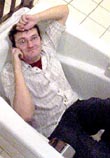|
|
This topic comprises 2 pages: 1 2
|
|
Author
|
Topic: threading
|
Ethan Harper
E-dawggg!!!

Posts: 325
From: Plano, TX, USA
Registered: May 2000
|
 posted 05-16-2000 10:28 PM
posted 05-16-2000 10:28 PM




i know this might be a stupid question to debate or ask about, but it will probably get erased if it is not worthy. O.K. here we go. how do you thread(considering that we are using platters here)
1. bottom up
2. top bottom
3. stupid old-skool method of threading to proj. motoring leader onto floor then to take-up platter. i personally was traineed top-bottom but then realized all of the flaws that are included in this technique. I am proud to say that i go bottom-up. this way no film has touched the floor to drag dirt from the floor to the platter to the print. Just curious on others methods and why.
| IP: Logged
|
|
|
|
|
|
Dwayne Caldwell
Master Film Handler

Posts: 323
From: Rockwall, TX, USA
Registered: Apr 2000
|
 posted 05-17-2000 04:00 AM
posted 05-17-2000 04:00 AM




I normally thread bottom up so I don't have to mess with letting loose the slack through the bottom pull down sprocket that you usually have when you lock the leader down on the bottom sprocket pad roller then thread top to bottom. That's not to say the method Joe uses is inferior. It's just a preference for me. I do, however, have to use Joe's threading scheme on Cinemecannica projectors. I could never get used to threading through the sound drum assembly backwards on those things. It might have something to do with that big ass sound drum pad roller.I was trained with the clothespins at GCC, but quickly got out of that habit when a fellow projectionist showed me the bottom sprocket pad roller trick, and I can't imagine using a clothespin for anything other than sealing an opened bag of chips. But the projectionists at AMC showed me the pile the leader on the floor trick! That's just sad. ------------------
The man with the magic hands.
| IP: Logged
|
|
John Walsh
Film God

Posts: 2490
From: Connecticut, USA, Earth, Milky Way
Registered: Oct 1999
|
 posted 05-17-2000 10:07 AM
posted 05-17-2000 10:07 AM




When training new operators, I show them "top-down" threading, and use a clean plastic trash can to place the leader in. I find this is easier to teach. If you give a totally inexperienced person a length of film and a projector (but don't actually show them anything) they will intuitively start at the top.Like anyone, I (myself) have little tricks to thread platters (top-down), yet keep the film clean without trash cans. I worked at one theater where threading "bottom-up" was the best way, but only that one place. So, it's not a personal preference thing; it really depends on the booth, equipment, etc. I need to add that I have a certain reason for only teaching "top-down with trash can" threading. Most of the people I have to teach are ushers who do _not_ want to learn. It's harder work, for which they get no extra money for. Many are openly hostile ("This sucks, man!") I get four shifts (while the theater is open) to teach them to at least thread. This is in addition to doing my own, regular tasks. After that, they are officially a "projectionist" and are put to work, until they quit or screw up so bad that management can't take it any more. If I try to teach them in a manner that appears to be counter-intuitive, (even if it is better in reality) it will take longer. Most of them are gone within six months. You might ask why we would hire such people, and the answer is upper management has reduced the quality and the pay for the job. Now, our only hope to keep the place reasonably staffed is to try to keep churning people through. If we got tough, we would have no staff at all.
| IP: Logged
|
|
|
|
Scott D. Neff
Theatre Dork

Posts: 919
From: San Francisco, CA
Registered: Oct 1999
|
 posted 05-17-2000 12:38 PM
posted 05-17-2000 12:38 PM





This used to be an ongoing debate within our company. Many of us were imported from UA where we ran Norelco FP-20's without working motor switches. So we were all taught to thread the platter - then the projector from the top down.I think we're split in half now - half the company does that, the other half pulls the film to the top feed roller and throws the leader on the floor, threads the projector and then the take-up platter. I find it to be a waste of time personally. I can thread all 4 platters - assembly line style, clean the projectors, assembly line style and then right before showtime, just pop the film into the projector and away we go. When I first started managing the 4-plex - I had cut all my leader to be almost PERFECT - so there was VERRRY little leader that would touch the floor if you threaded my way. In my year's absence... other managers have swapped films with other theatres and given away my perfectly cut, brand new(ish) leader. I'll admit... I don't have the energy to care about that again... Besides, I keep hearing rumors of Film-Guard. 
| IP: Logged
|
|
|
|
|
|
Scott Norwood
Film God

Posts: 8146
From: Boston, MA. USA (1774.21 miles northeast of Dallas)
Registered: Jun 99
|
 posted 05-17-2000 03:14 PM
posted 05-17-2000 03:14 PM





I have tried "threading up" and never really got the hang of it. I started with 16mm reel-to-reel setups and had always threaded "down"; when I started with 35mm (also reel-to-reel), I just stuck with the same approach; I was always careful to never let the film touch the floor. Part of this was the force of habit, but part of it was practical: with 35mm, I first put the film in the intermittent sprocket (after advancing the intermittent by hand) in order to get the framing right; then, I set the other loops. When threading "up," I'd have to thread the machine, then re-set every loop after putting the film in the intermittent sprocket.
Of course, all of this is a bigger issue with platters, where it's much harder to avoid getting film on the floor when threading "down"; I was taught to thread the platter side of things first (both feed and takeup), then the projector. Yes, I admit that film still touches the floor occasionally, but it's only the part of the leader that would never touch the projector head anyway.
The "motor the leader onto the floor" idea sounds absolutely awful, and I consider myself fortunate that I've never seen it done in practice.
| IP: Logged
|
|
|
|
|
|
|
|
|
|
John Pytlak
Film God

Posts: 9987
From: Rochester, NY 14650-1922
Registered: Jan 2000
|
 posted 05-18-2000 06:42 AM
posted 05-18-2000 06:42 AM





For platter operation, the "bottom to top" pattern seems to work the best for most people. With top-down, it is more difficult to keep film from touching the dirty floor.Brad is absolutely correct that dirt picked up by leader eventually transfers to the rest of the print. Always do your best to keep the film and leader from touching dirty surfaces. Keep the rewind bench, makeup table (MUT) and floor clean and free of debris. A quick wipe occasionally with a damp sponge or mop will pick up the dust and film chips that buildup during the workday. Kodak's new VISION color print film has a conductive back-side layer, to minimize attraction of dirt by static charging, and eliminate annoying static shocks during rewinding. A quick way to show the benefit of this is to quickly rub a short length of film between your fingers or on a pant leg to try to generate static, and hold it near a dusty surface (e.g., a dirty ashtray). The static charge on older films will attract the dirt to the film, the new Kodak VISION (2383, 2393) films will not. Unfortunately, some ads, trailers, policy and date snipes, and thread-up leaders are not made using the new conductive film, so static-attraction of dirt can still be an issue with them. ------------------
John P. Pytlak, Senior Technical Specialist
Worldwide Technical Services, Entertainment Imaging
Eastman Kodak Company
Research Labs, Building 69, Room 7419
Rochester, New York, 14650-1922 USA
Tel: 716-477-5325 Fax: 716-722-7243
E-Mail: john.pytlak@kodak.com
| IP: Logged
|
|
|
|
All times are Central (GMT -6:00)
|
This topic comprises 2 pages: 1 2
|
Powered by Infopop Corporation
UBB.classicTM
6.3.1.2
The Film-Tech Forums are designed for various members related to the cinema industry to express their opinions, viewpoints and testimonials on various products, services and events based upon speculation, personal knowledge and factual information through use, therefore all views represented here allow no liability upon the publishers of this web site and the owners of said views assume no liability for any ill will resulting from these postings. The posts made here are for educational as well as entertainment purposes and as such anyone viewing this portion of the website must accept these views as statements of the author of that opinion
and agrees to release the authors from any and all liability.
|

 Home
Home
 Products
Products
 Store
Store
 Forum
Forum
 Warehouse
Warehouse
 Contact Us
Contact Us




 Printer-friendly view of this topic
Printer-friendly view of this topic
















 . I found salvation about seven years ago when a new manager watched in horror as I ignorantly laced (threaded) the machine. Since then our leaders are staying much more cleaner, duh! Anyway, not that I'm proud of that, but I just thought I'd share my dirty secret with you.
. I found salvation about seven years ago when a new manager watched in horror as I ignorantly laced (threaded) the machine. Since then our leaders are staying much more cleaner, duh! Anyway, not that I'm proud of that, but I just thought I'd share my dirty secret with you.





